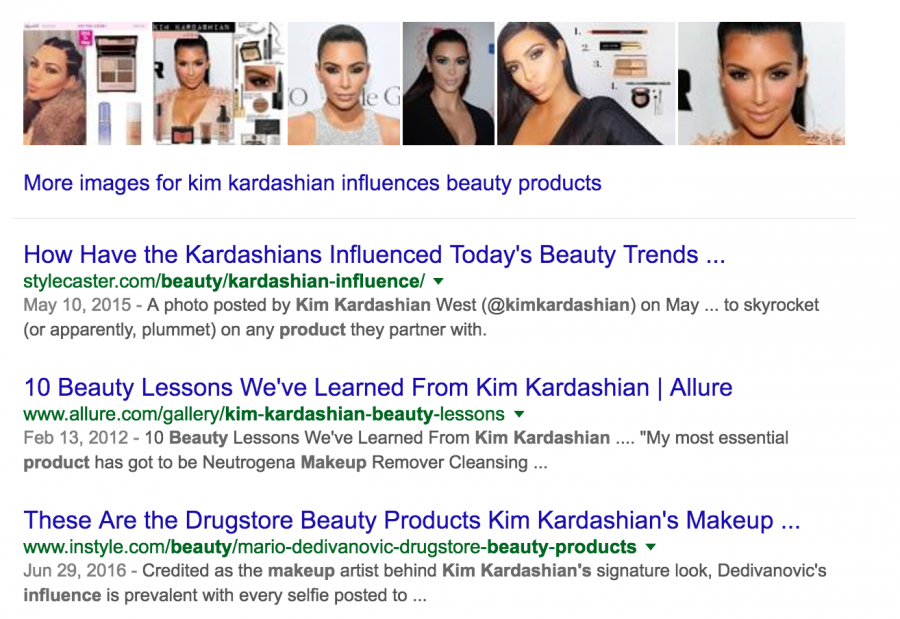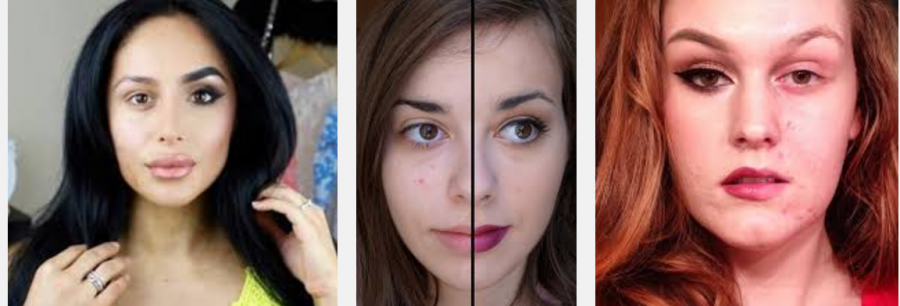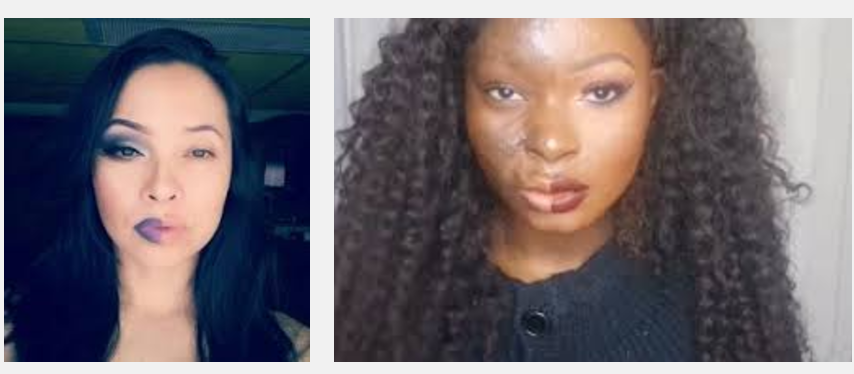
How do Kim Kardashian, Selena Gomez and Nikki Tutorials become role models?
Women, social media and appearance
This paper will discuss how women use social media to voice their opinions on appearance; how they transform from ordinary women to influential celebrity women. Social media have become a powerful tool to send a message on what the perfect image is. Whether it would be to fight for a natural look or to promote and endorse products to create the perfect image, women are using social media in order to influence others to follow a path and to reach the ideal appearance.
Social media as a voice
Recently, two videos on women protesting their appearance went viral on Facebook. The first one is a video by Channel 4 News, featuring a group of women in South Africa who protest the government, because they want to be accepted as they are, whilst wearing their ‘natural’ hair in an African hairstyle. In South Africa, women are preferred to have a more ‘European’ look by straightening their hair, or wearing weaves, especially when looking for a job. These South African women wanted to be accepted as they are and did not want to feel obligated to comply with socially desirable appearances. The protesters were completely opposed to this, because they wondered how wearing one’s natural hair can be seen as a political act. They felt that the government did not want to allow them to do anything that originates from their own culture.
The other video that went viral features Jae West, an actress and activist, sitting in the middle of Times Square in New York, with a sign asking everyone to help her to cut off her hair. On a poster she wrote the following message: “Beauty isn’t dependent on our external appearance. Cut or shave a piece of my hair to support this message”. As seen in the video, people were in shock and were hesitant to do what she requested, but eventually found the courage to do what was asked. In the end people supported her. The final message of the video was “our depth of beauty, like the ocean, is immeasurable by the surface”.
Both videos triggered me to analyze how women use social media to influence women’s appearances or to convey a message on this topic.
The power of social media
Research has shown that the social context of media use is crucial for people, particularly because significant others are relevant to the way people interpret and are affected by media (Milkie, 1999). Being social animals by nature, we are highly receptive to social media (Qualman, 2009). They employ mobile and web-based technologies to create highly interactive platforms through which individuals and communities share, co-create, discuss and modify user-generated content (Kietzmann, Hermkens, Mccarthy & Silvestre, 2011). A recent report from the Pew Research Center found that the percentage of female internet users who use social networking sites well surpasses that of men – 75% vs 63%, respectively (Webershandwick, 2016).
In a recent study, Klein (2013) found that marketers have perfected the ability to create a sense of desire and aspiration in society, thrusting “a very narrow ideal of female beauty” upon society, because they have learned what type of portrayal attracts customers, and therefore money. Through a variety of images of women, advertisers help dictate society’s opinions and aspirations regarding appearance. The images used within advertising are typically of “idealized human beings” and they therefore encourage the rest of society to strive to look the same.
In reality, what advertisers do through the use of nearly perfect models and actors in the advertisement, is to “actively promote a self-improvement motivation for comparison”. Nowadays, the perfect female body can't just be seen on the billboard down the street or in the commercial on TV, but is strategically, yet seamlessly placed on social networks. The unachievable ideal is deceivingly normalized through social media, and is misleadingly presented as achievable. Comparisons have only become stronger and more powerful, and as a result more and more drastic measures are taken to reach a certain ideal.
Idealized human beings
To further analyze how social media is used to influence, we will take a closer look at three popular social media celebrities and beauty influencers. Firstly, we will have a look at Kim Kardashian, who is an American reality TV star. She became “famous for being famous” and has had much success by knowing how to market herself to her fans via social media platforms.
Secondly, we will analyze Selena Gomez' use of social media. She is an American actress and singer, of mixed Mexican and Italian descent. Currently, she is one of the celebrities with the most followers on various social media platforms.
Lastly, we'll take a look at Nikki Tutorials, who is a professional hair and make-up artist from The Netherlands and a beauty guru on YouTube. All three use social media to publish beautiful pictures or content to endorse products. Moreover, they also use social media to share their thoughts on body shaming, bullying, overexposing yourself, women's appearances and other relevant topics they consider important to discuss with their fans. These women use their voice on social media not only to promote beautiful images of themselves, or to portray an "unachievable" image of perfection, but to voice their standpoints about relevant topics regarding women's appearances as well.
Let's take a closer look at these celebrities’ usage of their social media platforms. The following videos each portray a different scenario. Firstly, an interview with Kim Kardashian where she explains how social media have strengthened her success. Secondly, a speech by Selena Gomez in which she requests her fans not to expose themselves on social media to gain self-worth. Thirdly, a video made by Nikki, that went viral, about "the power of makeup". She expresses how make-up should not be used as a tool to change someone, but as a tool to accept one's looks.
Kim Kardashian
On October 23rd 2016, in an episode of 60 minutes on CBSNews, Kim Kardashian was speaking openly to correspondent Bill Whitaker about monetizing her public life. The segment was about how advertisers can reach Millennials. When Kim was asked if her fame could exist without social media she responded: “Not in this way. I totally attribute my career to social media.” Consider that she has one of the largest social media followings of all time. She posts pictures and gets paid for clothes she wears, products she uses, and brands she endorses (60 minutes on CBSNews, 2016).
According to Piazza, more Americans had heard of Paris Hilton than of Kim Kardashian in 2011. In recent years, Kim has surpassed Paris, according to the Davie Brown index, which determines a celebrity’s marketing value compared to a corporate brand. “Kardashian had a stronger appeal score,” Brown wrote, “was more likely to be a trendsetter, had more endorsement potential, and was more aspirational” (Halperin, 2016, p.155). More brands wanted to sign on Kardashian for endorsement deals, more consumers wanted to buy products that would allow them to be like her, and the public liked her better. Joan Barnes, president of Atlanta-based Marketing Specifics, revealed for example that a social-blogging company told her it had arranged for Kim to be paid $25,000 by Armani just for one tweet. The tweet drove forty thousand users to the Armani website in less than 30 minutes (Halperin, 2016). Kardashian and her sisters are known for being among the biggest influencers when it comes to driving consumer behavior. People want to imitate them by buying what they use, in order to fulfill the illusion of being able to look as pretty as the famous Kim Kardashian.

Figure 4: A snapshot made by Ashna Coster of endorsement deals of Kim Kardashian when Googled.
Selena Gomez
During the recent American Music Awards, Selena Gomez gave an acceptance speech in which she explained that she had everything, but that she was broken inside. Then, she continued saying that she does not want to see her fans’ bodies on Instagram anymore, but rather what is inside of their hearts. In her speech, she stated that she no longer seeks validation from anyone. She referred to her public relationship with her now-ex-boyfriend celebrity Justin Bieber.
Selena has over 103 million followers on Instagram and 46 million on Twitter. Knowing that her fan base is a loyal one, she wants her fans to stop exposing themselves to feel accepted. There is no need to display your body or beauty in order to get validation from anyone. This is a powerful statement, because it is coming from someone, who on various occasions has displayed herself in sexy and provocative ways on social media, but is now requesting her fans not to do so. Someone's outer beauty should not be an important factor, it's what's on the inside that counts.
Nikkie
Nikkie is currently a well-known beauty guru with millions of followers on all of her social media platforms. What sets her apart, is the fact that she does not have a typical ‘Barbie doll’ appearance. Nikkie is a micro-celebrity who makes how-to videos. She is not an actress from Hollywood or a model for Sports Illustrated or Victoria's Secret. She's an average girl, one might even consider her a potential friend or neighbour, who gained a huge following thanks to her amazing skills and artistry.
In various interviews, Nikkie explained that her passion for make-up started when he was looking for beauty how-to videos on YouTube and one day decided to start doing make-up tutorials herself on how to achieve difficult make-up looks in a simpler way. She became a figure her viewers could relate to and gained a huge group of followers. Important to her is that people understand that make-up gives women the opportunity to feel good. The power of make-up can be seen as a positive force, helping women to gain self-esteem and confidence. Regardless of your ethnic background, make-up can be used as a positive influence. She used her success to start a make-up trend that went viral: “the power of make-up”. This trend included that one side of the face would be fully ‘glammed up’ and the other side would remain plain. This initiative was taken to showcase that women should embrace their natural beauty, but can also enhance it with make-up.

Figure 6: A collage made by Ashna Coster of various women who did the same video as Nikki on The Power of Makeup

Figure 6: A collage made by Ashna Coster of various women who did the same video as Nikki on The Power of Makeup
The power of social media to influence women’s appearances
Social media have helped women to voice their opinions on looks and appearances. Whether it'sto stand up for what they believe is the ideal image, or to create an illusion of the ideal image. Marketers create a sense of desire and aspiration in society; the ideal of female beauty, which encourages people to look the same. Nowadays, the image of perfection is not only on billboards and in magazines, but is strategically placed on social media. In contrast to only encouraging a certain ideal image, social media also give women the opportunity to stand up against what the marketers portray as perfect. Social media give women the opportunities for empowerment; to demonstrate who and how they naturally are.
Social media provide celebrities, such as Kim Kardashian, with the opportunity to become an influence on consumer behavior, and show how someone like Selena Gomez encourages women to stop looking for validation by exposing their bodies. Nikkie is also a great example of how social media are a tool, used to influence women. Despite her lack of resemblance to Barbie, she still has a huge fan base that has an interest in beauty. All three women gained power thanks to social media. This way, they have the power to make people want to imitate them, the power to stimulate them to buy whatever products they use, but also, and more importantly, the power to stand up for what they believe in and what they perceive is perfection.
References
CBSnews. (2016, October 26). Kim Kardashian facing backlash after 60 minutes interview. Retrieved on 23 November 2016.
Chanel 4 news. (2016, August 31). “We want to be accepted just the way we are.” These black women react to protest over natural hair in South Africa.. Retrieved on 23 November 2016.
Halperin, I. (2016). Kardashian dynasty. New York: Gallery Books.
Kietzmann, J. H., Hermkens, K., Mccarthy, I., & Silvestre, B. S. (2011). Social media? Get serious. Understanding the functional building blocks of social media. Business Horizons, 54(3), 241-251. Doi: 10.1016/j.bushor.2011.01.005
Klein, K.M. (2013). Why Don’t I Look Like Her? The Impact of Social Media on Female Body Image.
Milkie, M. A. (1999). Social Comparisons, Reflected Aprraisals, and Mass Media: The Impact of Pervasive Beauty Images on Black and White Girls’ Self-Concepts. Social Psychology Quarterly, 62(2), 190. Doi: 10.2307/2695857
Qualman, E. (2009). Socialnomics: How social media transforms the way we live and do business. Hoboken, NJ: Wiley.
Selena Gomez Canada. (2016, November 20). Selena Gomez AMAs 2016. Acceptance Speech for Pop/Rock Female Artist Of the Year. Retrieved on 23 November 2016;
The Liberators international. (2016, September 6). She let the public cut her hair off [Facebook post]. Retrieved on 23 November 2016.
[Webershandwick]. (n.d.). Retrieved November 29, 2016.